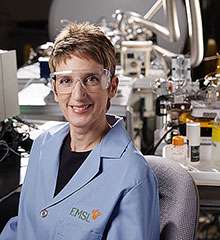A trailblazer in top down proteomics

Ljiljana Paša-Tolic, better known as Lili, is EMSL's mass spectroscopy capability lead. With a scientific focus in biology, she is particularly interested in the biological applications of mass spectroscopy technology.
Paša-Tolic's primary research area is proteomics – the study of proteins, particularly their structures and functions. Most proteomics research is from bottom up, which means the proteins are broken up and analyzed using liquid chromatography coupled with mass spectroscopy. Bottom up proteomics gives researchers a broad look at the proteins present in the sample, but does not identify the diversity of the protein forms, or proteoforms.
Paša-Tolic recognized early in her career a bottom up approach to protein analysis was useful, but limiting. She believed the information from bottom up proteomics was incomplete.
"When a protein is broken into small pieces, none of the pieces give the full picture of the whole proteoform," she says.
She spent two decades helping develop the tools and process for intact protein analysis, or top down proteomics. Top down proteomics analyzes the proteoform, or entire protein, rather than analyzing the peptides, or tiny pieces of a protein. Fourier transform mass spectrometry, such as ion cyclotron resonance and Orbitrap, make top down analysis possible.
"Top down analysis is a distinct tool that allows scientists to know what to look for in the bottom up data, but they need to know what to look for," says Paša-Tolic.
The proteomics research at EMSL uses both approaches – bottom up and top down. The more common analysis is bottom up. Paša-Tolic believes top down proteomics, while still limited, will enable new biological discoveries.
One of her current research focuses is histones, or the basic proteins that organize DNA and control gene expression. She believes histones are an excellent model system for top down mass spectrometry to help answer fundamental biological questions about gene expression in fungi, plants and mammals. Paša-Tolic's research on histones supports the mission of Department of Energy Office of Biological and Environmental Research by trying to understand how genomic information is translated to functional capabilities, such as redesigning microbes and plants for biofuel production or contaminant bioremediation.
Paša-Tolic's holds a leadership role in the Consortium for Top Down Proteomic. She is a member of the organizing committee and a consortium investigator.
Recently, Paša-Tolic co-organized the American Society for Mass Spectrometry 2013 Sanibel Conference on Top Down Mass Spectrometry in Florida. The 25th annual conference last January gathered 135 attendees from 16 countries. She also spoke at the conference on current state-of-the-art approaches enabling quantitative studies of bacterial proteomes.
Seeing the potential
Paša-Tolic saw the scientific potential of the FTICR mass spectrometry for biology research while earning her doctorate in physical chemistry at the University of Zagreb in Croatia. She liked the technique and wanted to pursue it as a postdoc.
It was the early 1990s, and her homeland was in the Croatian War of Independence from what was then Yugoslavia. She applied to be a postdoctoral assistant with Alan Marshall at the National High Magnetic Field Laboratory at Florida State University, Tallahassee. Marshall is one of the inventors of FTICR, and is one of the top scientists using it.
"It was very difficult times and science wasn't the first priority for anyone," says Paša-Tolic. "I was very lucky to have been selected by Alan as his first postdoc at the magnet lab."
One of her primary jobs at Marshall's laboratory was designing the FTICR 9.4 Tesla, which would be the most powerful FTICR spectrometer available at the time.
"It was a very exciting time," notes Paša-Tolic. "I had to learn how to design things mechanically, which was a lot of fun."
After two years of technology development with Marshall, Paša-Tolic wanted to do more biological research. The most prestigious facility doing biology research with FTICR was Pacific Northwest National Laboratory under the direction of Dick Smith, Battelle Fellow and chief scientist. In 1995, she applied for and became a postdoctoral fellow at PNNL working with Smith.
Her first job at PNNL was helping startup the FTICR 11.4 Tesla, the highest magnetic field strength instrument at the time. Paša-Tolic is proud to say she was part of the team that got the first data from that instrument.
Designing new technology
Paša-Tolic is currently developing EMSL's FTICR 21 Tesla, which will be tied as the highest field instrument of its kind when complete. BER is funding the project. Paša-Tolic's former mentor is also developing a FTICR 21 Tesla, but Marshall's instrument is being funded by the National Science Foundation. EMSL and the National High Magnetic Field Laboratory are collaborating on the development of the two instruments.
Researchers will use EMSL's FTICR 21 Tesla to analyze natural organic matter in complex environmental mixtures for research into BER mission areas, such as carbon cycling and environmental change.
"If built right, this spectrometer will provide a transformative capability that makes experiments that are now heroic efforts into routine procedures," she says.
Paša-Tolic boasts an impressive vita. In addition to the consortium and the Sanibel conference, she has chaired and presented at numerous scientific committees and conferences. She has authored or co-authored more than 140 peer-reviewed scientific publications and book chapters, and is currently editing a special edition of peer-reviewed journal Proteomics on top down mass spectrometry. Paša-Tolic holds two Pacific Northwest National Laboratory Key Contributor awards.
One of her most significant research accomplishments, Paša-Tolic developed the first stabilized labeling in proteomics. It allows researchers to accurately quantify changes in protein abundance under different conditions, such as when an organism is diseased or healthy or in response to stimuli.
"I love what I do," says Paša-Tolic. "I want to keep developing the best technologies geared at answering the most pressing questions in biology."
Journal information: Proteomics
Provided by Environmental Molecular Sciences Laboratory


















